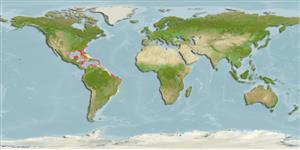Demospongiae |
Axinellida |
Axinellidae
Environment: milieu / climate zone / depth range / distribution range
Ecology
Sessile; depth range 5 - 71 m (Ref. 108813). Tropical
Western Central Atlantic: Caribbean and USA.
Length at first maturity / Size / Weight / Age
Maturity: Lm ? range ? - ? cm
Morphology: branching, bushy, tube. Surface very corrugated (Ref. 81782). Consistency: tough and rubbery. Color: Orange to orange-yellow (Ref. 81782), yellow, or red-orange (Ref. 85482).
Occurs on coral reefs and hard bottoms at depths between 18 to 90 m (Ref. 85482).
Life cycle and mating behavior
Maturity | Reproduction | Spawning | Eggs | Fecundity | Larvae
Members of the class Demospongiae are hermaphroditic. Life cycle: The zygote develops into parenchymella larva (free-swimming) before settling down on a substrate where it grows into a young sponge.
Bisby, F.A., M.A. Ruggiero, K.L. Wilson, M. Cachuela-Palacio, S.W. Kimani, Y.R. Roskov, A. Soulier-Perkins and J. van Hertum 2005 Species 2000 & ITIS Catalogue of Life: 2005 Annual Checklist. CD-ROM; Species 2000: Reading, U.K. (Ref. 19)
IUCN Red List Status
(Ref. 130435: Version 2025-1)
CITES status (Ref. 108899)
Not Evaluated
Not Evaluated
Threat to humans
Human uses
| FishSource |
Tools
More information
Trophic EcologyFood items (preys)
Diet composition
Food consumption
Predators
Population dynamicsGrowth
Max. ages / sizes
Length-weight rel.
Length-length rel.
Length-frequencies
Mass conversion
Abundance
Life cycleReproductionMaturityFecunditySpawningEggsEgg developmentLarvae PhysiologyOxygen consumption
Human RelatedStamps, coins, misc.
Internet sources
Estimates based on models
Preferred temperature
(Ref.
115969): 23.4 - 27.7, mean 25.5 (based on 170 cells).
Price category
Unknown.
